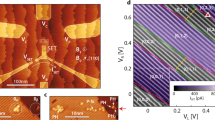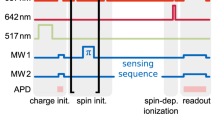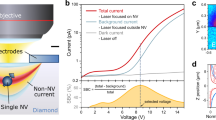Abstract
The performance of qubit-based technologies can be strongly limited by environmental sources of noise and disorder that cause decoherence. Qubits used in quantum sensing are usually very close to the host surface to enhance their coupling to external targets. This leaves them vulnerable to the effects of the surrounding noisy electron spin bath near the surface, which is very challenging to eliminate. Here we developed an efficient method to engineer the immediate electrostatic environment of nitrogen vacancy centre qubits located several nanometres beneath the diamond surface. We adopt a ‘pull-and-push’ strategy for near-surface charge manipulation using the strong local electric field of an atomic force microscope tip. Our technique is particularly effective for extremely shallow nitrogen vacancy centres, increasing their spin echo time by up to 20 fold. This corresponds to an 80-fold enhancement in the potential sensitivity for detecting individual external proton spins. Our work not only represents a step towards overcoming a fundamental restriction to applications of shallow nitrogen vacancy centres for quantum sensing but may also provide a general route for enhancing the coherence of solid-state qubits.
This is a preview of subscription content, access via your institution
Access options
Access Nature and 54 other Nature Portfolio journals
Get Nature+, our best-value online-access subscription
$29.99 / 30 days
cancel any time
Subscribe to this journal
Receive 12 print issues and online access
$209.00 per year
only $17.42 per issue
Buy this article
- Purchase on Springer Link
- Instant access to full article PDF
Prices may be subject to local taxes which are calculated during checkout




Similar content being viewed by others
Data availability
Source data that support the findings of this study are available with this paper. All other data that support the plots within this paper are available from the corresponding authors upon reasonable request. Source data are provided with this paper.
Code availability
The custom codes for fitting the data are available from the corresponding authors upon reasonable request.
References
Balasubramanian, G. et al. Nanoscale imaging magnetometry with diamond spins under ambient conditions. Nature 455, 648–651 (2008).
Maze, J. R. et al. Nanoscale magnetic sensing with an individual electronic spin in diamond. Nature 455, 644–647 (2008).
Mamin, H. J. et al. Nanoscale nuclear magnetic resonance with a nitrogen-vacancy spin sensor. Science 339, 557–560 (2013).
Staudacher, T. et al. Nuclear magnetic resonance spectroscopy on a (5-nanometer)3 sample volume. Science 339, 561–563 (2013).
Shi, F. Z. et al. Single-protein spin resonance spectroscopy under ambient conditions. Science 347, 1135–1138 (2015).
Rosskopf, T. et al. Investigation of surface magnetic noise by shallow spins in diamond. Phys. Rev. Lett. 112, 147602 (2014).
Romach, Y. et al. Spectroscopy of surface-induced noise using shallow spins in diamond. Phys. Rev. Lett. 114, 017601 (2015).
Myers, B. A., Ariyaratne, A. & Jayich, A. C. B. Double-quantum spin-relaxation limits to coherence of near-surface nitrogen-vacancy centers. Phys. Rev. Lett. 118, 197201 (2017).
de Lange, G., Wang, Z. H., Riste, D., Dobrovitski, V. V. & Hanson, R. Universal dynamical decoupling of a single solid-state spin from a spin bath. Science 330, 60–63 (2010).
Bluvstein, D., Zhang, Z. R., McLellan, C. A., Williams, N. R. & Jayich, A. C. B. Extending the quantum coherence of a near-surface qubit by coherently driving the paramagnetic surface environment. Phys. Rev. Lett. 123, 146804 (2019).
Li, R. et al. Nanoscale electrometry based on a magnetic-field-resistant spin sensor. Phys. Rev. Lett. 124, 247701 (2020).
Miao, K. C. et al. Universal coherence protection in a solid-state spin qubit. Science 369, 1493–1497 (2020).
Schmitt, S. et al. Submillihertz magnetic spectroscopy performed with a nanoscale quantum sensor. Science 356, 832–837 (2017).
Aslam, N. et al. Nanoscale nuclear magnetic resonance with chemical resolution. Science 357, 67–71 (2017).
Abobeih, M. H. et al. Atomic-scale imaging of a 27-nuclear-spin cluster using a quantum sensor. Nature 576, 411–415 (2019).
Gross, I. et al. Real-space imaging of non-collinear antiferromagnetic order with a single-spin magnetometer. Nature 549, 252–256 (2017).
Thiel, L. et al. Probing magnetism in 2D materials at the nanoscale with single-spin microscopy. Science 364, 973–976 (2019).
Ku, M. J. H. et al. Imaging viscous flow of the Dirac fluid in graphene. Nature 583, 537–541 (2020).
Dolde, F. et al. Electric-field sensing using single diamond spins. Nat. Phys. 7, 459–463 (2011).
Bian, K. et al. Nanoscale electric-field imaging based on a quantum sensor and its charge-state control under ambient condition. Nat. Commun. 12, 2457 (2021).
Kucsko, G. et al. Nanometre-scale thermometry in a living cell. Nature 500, 54–58 (2013).
Neumann, P. et al. High-precision nanoscale temperature sensing using single defects in diamond. Nano Lett. 13, 2738–2742 (2013).
Wu, Y. Z., Jelezko, F., Plenio, M. B. & Weil, T. Diamond quantum devices in biology. Angew. Chem. Int. Ed. 55, 6586–6598 (2016).
Le Sage, D. et al. Optical magnetic imaging of living cells. Nature 496, 486–489 (2013).
Taylor, J. M. et al. High-sensitivity diamond magnetometer with nanoscale resolution. Nat. Phys. 4, 810–816 (2008).
Degen, C. L., Reinhard, F. & Cappellaro, P. Quantum sensing. Rev. Mod. Phys. 89, 035002 (2017).
Barry, J. F. et al. Sensitivity optimization for NV-diamond magnetometry. Rev. Mod. Phys. 92, 015004 (2020).
Deak, P., Aradi, B., Kaviani, M., Frauenheim, T. & Gali, A. Formation of NV centers in diamond: a theoretical study based on calculated transitions and migration of nitrogen and vacancy related defects. Phys. Rev. B 89, 079905 (2014).
Lovchinsky, I. et al. Nuclear magnetic resonance detection and spectroscopy of single proteins using quantum logic. Science 351, 836–841 (2016).
de Oliveira, F. F. et al. Tailoring spin defects in diamond by lattice charging. Nat. Commun. 8, 15409 (2017).
Sangtawesin, S. et al. Origins of diamond surface noise probed by correlating single-spin measurements with surface spectroscopy. Phys. Rev. X. 9, 031052 (2019).
Giessibl, F. J. Advances in atomic force microscopy. Rev. Mod. Phys. 75, 949–983 (2003).
Giessibl, F. J. The qPlus sensor, a powerful core for the atomic force microscope. Rev. Sci. Instrum. 90, 011101 (2019).
Dwyer, B. L. et al. Probing spin dynamics on diamond surfaces using a single quantum sensor. Preprint at https://arxiv.org/abs/2103.12757 (2021).
Hammer, N. I. et al. How do small water clusters bind an excess electron? Science 306, 675–679 (2004).
Hauf, M. V. et al. Chemical control of the charge state of nitrogen-vacancy centers in diamond. Phys. Rev. B 83, 081304 (2011).
Zhao, N. et al. Sensing single remote nuclear spins. Nat. Nanotechnol. 7, 657–662 (2012).
Staudacher, T. et al. Probing molecular dynamics at the nanoscale via an individual paramagnetic centre. Nat. Commun. 6, 8527 (2015).
Pfender, M. et al. High-resolution spectroscopy of single nuclear spins via sequential weak measurements. Nat. Commun. 10, 594 (2019).
Cujia, K. S., Boss, J. M., Herb, K., Zopes, J. & Degen, C. L. Tracking the precession of single nuclear spins by weak measurements. Nature 571, 230–233 (2019).
Shields, B. J., Unterreithmeier, Q. P., de Leon, N. P., Park, H. & Lukin, M. D. Efficient readout of a single spin state in diamond via spin-to-charge conversion. Phys. Rev. Lett. 114, 136402 (2015).
Taminiau, T. H. et al. Detection and control of individual nuclear spins using a weakly coupled electron spin. Phys. Rev. Lett. 109, 137602 (2012).
Wolfowicz, G. et al. Quantum guidelines for solid-state spin defects. Nat. Rev. Mater. 6, 906–925 (2021).
Gottscholl, A. et al. Initialization and read-out of intrinsic spin defects in a van der Waals crystal at room temperature. Nat. Mater. 19, 540–545 (2020).
Evans, R. E. et al. Photon-mediated interactions between quantum emitters in a diamond nanocavity. Science 362, 662–665 (2018).
Widmann, M. et al. Coherent control of single spins in silicon carbide at room temperature. Nat. Mater. 14, 164–168 (2015).
Degen, M. J. et al. Entanglement of dark electron-nuclear spin defects in diamond. Nat. Commun. 12, 3470 (2021).
Pan, S. H., Hudson, E. W. & Davis, J. C. He-3 refrigerator based very low temperature scanning tunneling microscope. Rev. Sci. Instrum. 70, 1459–1463 (1999).
Pham, L. M. et al. NMR technique for determining the depth of shallow nitrogen-vacancy centers in diamond. Phys. Rev. B 93, 045425 (2016).
Acknowledgements
We thank F. Giessibl for his valuable help on qPlus-based AFM under ambient condition. This work was supported by the National Key R&D Program under grant nos. 2021YFA1400500 and 2017YFA0205003, the National Natural Science Foundation of China under grant nos. 11888101 and 21725302 and the Strategic Priority Research Program of the Chinese Academy of Sciences under grant no. XDB28000000. Y.S. and S.Y. were supported by Hong Kong RGC (GRF/14304618). R.S., A.D. and J.W. were supported by the ERC grant SMeL and the VW Foundation.
Author information
Authors and Affiliations
Contributions
Y.J. and S.Y. designed and supervised the project. K.B. constructed the experimental setup. R.S. and A.D. grew the diamond chips and fabricated the shallow NVs. W.Z. and K.B. performed the experiments and data acquisition. W.Z., K.B., X.C., Y.S., S.C., J.W., S.Y. and Y.J. performed the data analysis and interpretation. K.B., S.Y. and Y.J. wrote the article, with input from all other authors. All the authors commented on the final article.
Corresponding authors
Ethics declarations
Competing interests
The authors declare no competing interests.
Peer review
Peer review information
Nature Physics thanks Helena Knowles and the other, anonymous, reviewer(s) for their contribution to the peer review of this work.
Additional information
Publisher’s note Springer Nature remains neutral with regard to jurisdictional claims in published maps and institutional affiliations.
Extended data
Extended Data Fig. 1 Suitable tip position for T2 enhancement in ‘pushing’ step.
a, The confocal mapping when a negatively biased tip is scanned over a single shallow NV centre. The dark disk-like feature corresponds to NV+ state, caused by the strong tip-induced upward band bending effect. Scale bar: 500 nm. Laser power: 30 μW. Tip bias: −220 V. b, Schematic diagram showing the tip-induced band bending effect. When the tip is laterally close to NV within 300 nm, the large upward band bending effect induced by the negatively biased tip leads to NV+ state. The charge transition levels of NV+/NV0 and NV0/NVˉ are denoted by the short blue and red lines, respectively. The charge transition level of paramagnetic spins is denoted by the purple line. EF is the Fermi level, EC and EV denote the edges of the conduction and valance bands, respectively. c,d, Spin-echo mapping of one NV centre in the ‘pushing’ step under the tip bias of −100 V and −150 V, respectively, by fixing the delay time of spin-echo measurements. The images were expanded from 20 × 20 pixels to 40 × 40 pixels through the interpolation. The white disc denotes the position of NV. A grey arrow denotes the scanning direction, along which an overall decay of spin-echo signal was observed due to the thermal drift during the 6-hours imaging. The ‘hot’ regions demonstrating the longer T2 time are highlighted by the dashed curves. Scale bar: 400 nm. e, The T2 measurements at different positions in c. At every position denoted by the alphabets in c, we applied spin-echo measurements at full time range and fitted the T2. The dashed horizontal line denotes the original T2. The variation of T2 in e indicates the suitable tip position for enhancing the T2 under the ‘pushing’ step.
Extended Data Fig. 2 DEER spectra for depth calibration of shallow NVs.
a, Schematics showing the principle of DEER measurement. An extra π-pulse is applied at the middle of the spin-echo sequence, flipping the surrounding electron spins. Thus, the magnetic field from electron spins is sensed by the NV centre. b, Typical results of DEER spectra and spin-echo of a single shallow NV. Additional decoherence caused by the electron spins obviously appears in the DEER. c, Normalized DEER spectra for eliminating unwanted oscillations and peaks caused by the 13C residual spins or misalignment of biased magnetic field. d, Two typical normalized DEER spectra demonstrated in log-log plot of two shallow NV centres. The transition time is clearly observed, which reflects the depth of the NV centres. The dashed and dotted lines represent the powers of 2 and 2/3, respectively. e, The graph summarizing seven measured NV centres, which shows a positive relation between T2 and the depth. The red curve is used for guiding the eyes.
Extended Data Fig. 3 Transition time in log-log plot of DEER spectra before and after the coherence enhancement.
The DEER spectra of single NV demonstrated in the log-log plot showing the change of the transition time from ~21 μs to 64 μs before and after the charge manipulation. The coherence time was enhanced from 57 ± 3 μs up to 151 ± 5 μs. The dashed and dotted lines represent the powers of 2 and 2/3, respectively. In the model of configurational averaged surface spins, the transition time at which the DEER curve begins to demonstrate stretched exponential decay should be only sensitive to the depth of NV, regardless of the density of surface spins34. However, there should be subsurface electron spins such as P1 centre and charged vacancies induced by the ion implantation, which would also contribute to the decoherence and DEER signals of shallow NVs. Such subsurface spins may be located between the NV and the diamond surface, hence, the change of transition time indicates a changed distribution of the subsurface spins.
Extended Data Fig. 4 Sensitivity enhancement for proton detection.
a, Schematics showing the principle of detecting external protons by single NV centre. An ensemble of protons within the detecting volume (highlighted) contribute signals. b, The calculated sensitivity of single NV and its dependence on nτ according to the Equation 5. The detected field strength \(B_{{{{\mathrm{rms}}}}}^2\) is chosen to be fitted from the red curve in d. The grey curve shows the corresponding signal contrast calculated by the Equation 4. The blue curve shows the sensitivity calculated based on the approximation of tiny signal contrast (Supplementary Text 5). Only within the region of small signal contrast (highlighted), the red and blue curve show good consistence. For simplicity, both the sensitivity and signal contrast were calculated by setting \(C(n\tau )\)=1. c, Spin-echo measurements of a very shallow NV showing T2 enhancement of ~20 fold with our method. d, XY8-2 (blue curve) and XY8-12 (red curve) measurements of the same NV in c showing that after ‘pull-and-push’ method, such a quantum sensor with poor coherence can be used for detecting external protons, with the capability of detecting a minimum magnetic variance corresponding to ~0.18 protons. The red curve is offset for clarity. The external magnetic field is 303 Gauss.
Extended Data Fig. 5 Laser power dependence of surface polarization.
The fluorescence of one shallow NV centre under varied laser power with tip bias of +50 V (red points). The NVˉ completely coverts into NV+ at ~100 μW, which can be considered as a criterion for the degree of surface polarization. Assuming that there is no geometric change in the gaussian-like focus spot at different laser power, this transition laser power can be used for the estimation of polarized area. For example, considering the typical size of our laser focus and the power used during the ‘pulling’ step, we can estimate a polarized area of ~ 265 × 265 nm2 under a laser power of ~300 μW and a tip bias of +50 V. Inset: the schematics showing the process of surface polarization described in Methods. When polarizing the surface, we fixed the laser focus on one NV centre and scanned the tip with positive bias around it.
Supplementary information
Supplementary information
Supplementary Texts 1–7, Table 1, Figs. 1–7 and refs. 1–16.
Source data
Source Data Fig. 1
Raw data for Fig. 1c.
Source Data Fig. 2
Raw data for Fig. 2a–c.
Source Data Fig. 3
Raw data for Fig. 3b,c.
Source Data Fig. 4
Raw data for Fig. 4b–e.
Source Data Extended Data Fig. 1
Raw data for Extended Data Fig. 1a,c,d,e.
Source Data Extended Data Fig. 2
Raw data for Extended Data Fig. 2b–e.
Source Data Extended Data Fig. 3
Raw data for Extended Data Fig. 3.
Source Data Extended Data Fig. 4
Raw data for Extended Data Fig. 4c,d.
Source Data Extended Data Fig. 5
Raw data for Extended Data Fig. 5.
Rights and permissions
Springer Nature or its licensor holds exclusive rights to this article under a publishing agreement with the author(s) or other rightsholder(s); author self-archiving of the accepted manuscript version of this article is solely governed by the terms of such publishing agreement and applicable law.
About this article
Cite this article
Zheng, W., Bian, K., Chen, X. et al. Coherence enhancement of solid-state qubits by local manipulation of the electron spin bath. Nat. Phys. 18, 1317–1323 (2022). https://doi.org/10.1038/s41567-022-01719-4
Received:
Accepted:
Published:
Issue Date:
DOI: https://doi.org/10.1038/s41567-022-01719-4



